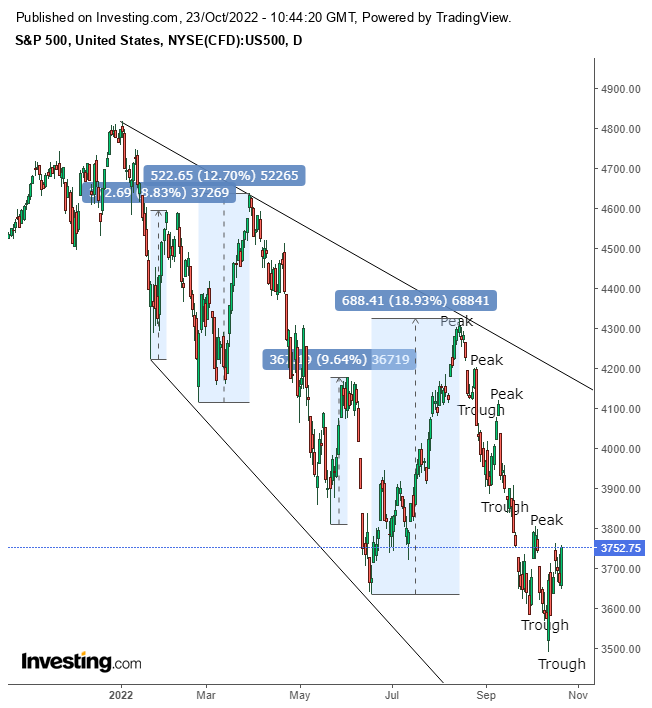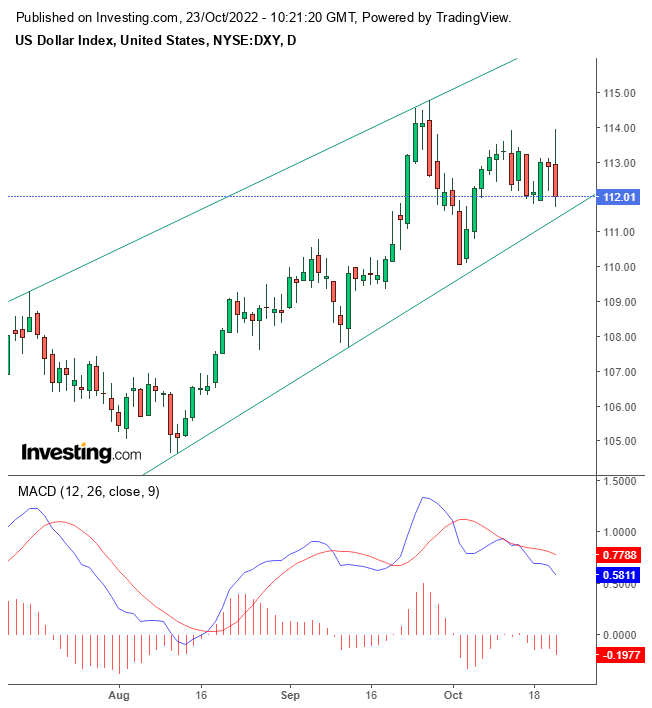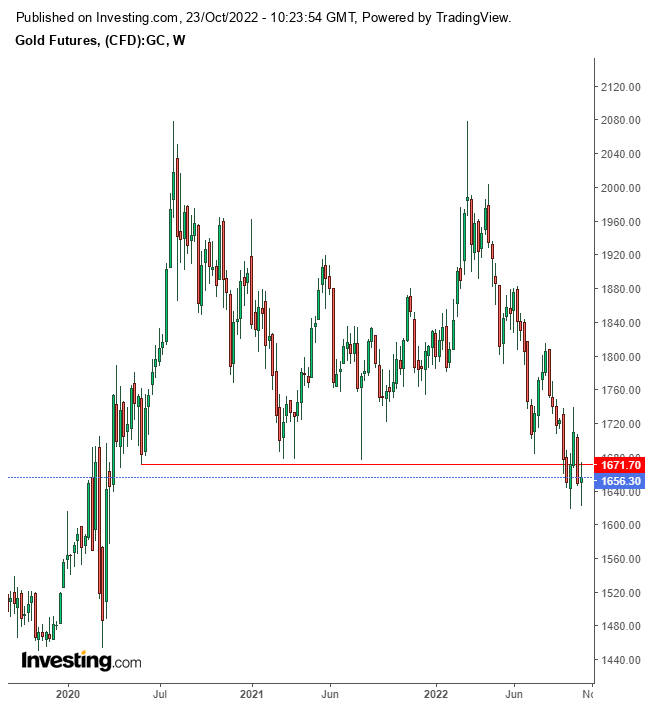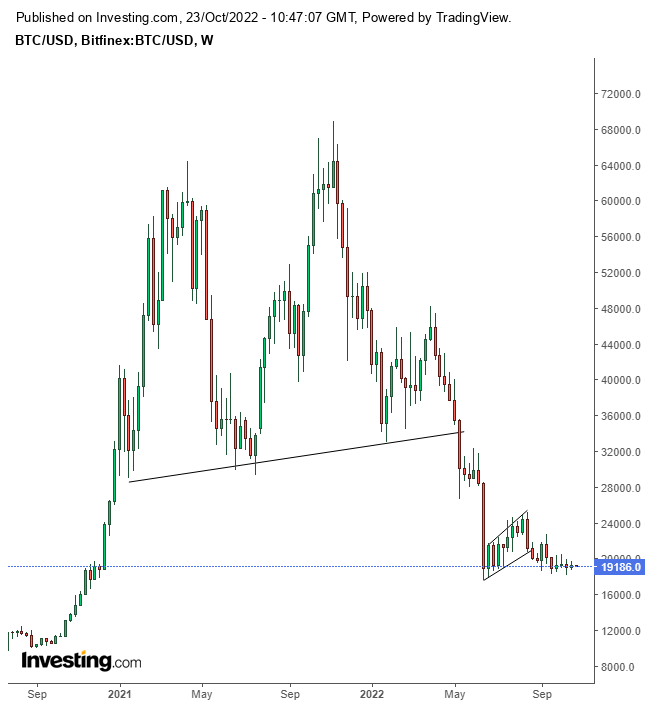- The relationship between treasuries and stocks cannot be taken for granted
- Corporate earnings and central bank meetings will test the market rebound
- Bear markets also include upward rallies; that doesn't mean a bottom is in
Treasury Yields
Analysts expect equities to maintain a negative correlation with easing yields as long as big tech and energy corporations don't perform terribly. However, the above statement includes a faulty premise that yields and equities have been consistently showing a negative correlation. They have not.

The 60-minute chart shows that the two assets have only had an inverse relationship since late Thu. However, the S&P 500 Index bottomed for an entire week before that, positively correlated with rising yields. In the medium term, the S&P 500 Index and 10-year yields moved in opposite directions.

Beware, markets are unpredictable. Allegiances change. Trading is about rolling with the punches and risk management. Some market participants believe that Treasury yields might be peaking in the short term. Friday's 10-year T-notes' yields closed well off their highs, possibly forming an imperfect, powerfully bearish shooting star. Powerful for its extreme drop from its intraday high, flawed for ending higher than its intraday low, which could have potentially deflated bearish expectations. I reiterate the S&P 500 and 10-year yields were inconsistent. So, although easing yields suggests lower rate hike expectations, rendering stocks more attractive, it is not an ironclad strategy.
Before the rate cycle, yields and equities possessed a positive correlation when investors were buying stocks at the expense of equities when assuming risk and vice versa when seeking shelter. So, if traders' betting on rate hikes will indeed peak, who's to say that stocks and yields won't return to their pre-rate cycle relationship?
Whatever the case may be, I expect considerable volatility, as institutions may try to figure out the new market normal after 10-year yields climbed for 12 weeks straight - in its longest winning streak (or longest losing streak for the underlying bonds) since 1984, when Fed Chairman Paul Volcker was doing the same that Powell has been doing, aggressively raising rates - in Powell's case, to the highest levels since mid-2008.
Meanwhile, swap traders' bets increased to their recent highest level, pricing in a 5% rate in the first half of 2023.
Rate Meetings
Adding to my expectation for volatility, both the Bank of Japan and the European Central Bank will make rate decisions on Thursday, while the Federal Reserve will hold its two-day policy meeting the following week, on November 2-3.
Earnings
Roughly 150 S&P 500 companies will reveal quarterly reports this week, including big tech bellwethers like Amazon (NASDAQ:AMZN), Microsoft (NASDAQ:MSFT), Apple (NASDAQ:AAPL), Alphabet (NASDAQ:GOOGL), and Meta Platforms. Also, energy supermajors Exxon Mobil (NYSE:XOM) and Chevron (NYSE:CVX) will post earnings.
I have been reporting that institutions have been consistently reducing expectations to justify an upside surprise when earnings are not terrible to revive the market's animal spirit. Investment banks are always selling.
Technicals
US stocks surged Friday, with all four major indexes adding more than 2% in their best week since June, and traders are talking again about a bottom and the time to buy stocks, as if stocks are expected to go down in a straight line in a bear market. It's natural and normal for a bear market to have rallies. That doesn't mean stocks are bottoming (other than in the short term). Let's look at the next chart.

We see numerous short-term rallies within the downward trend. The S&P 500 rebounded from its June 19 low nearly 19%, a move that triggered bitter debates about the market's direction. Amid that near-bull market rally (a 20% up-move as arbitrarily measured by Wall Street), I bet on the downtrend, predicting the S&P 500 will make another low. I reiterated that call on August 25. Stocks have been tumbling down since. While they may rebound in the short term, for as long as the peaks and troughs point down, they are likelier to continue lower in the medium and long term.

The Dollar is testing its rising channel. The MACD indicates Greenback might break to the downside.

Gold found support Friday by September lows, though bulls will have to prove they have what it takes to climb back above the $1,700 level after completing a double top. The odds are better for a continued downtrend after penetrating the neckline of 3%.

Bitcoin has been flat for the fifth straight week, trading in a roughly 10% band, unusually narrow for the highly volatile instrument. I still expect the cryptocurrency to continue its downside course.
Crude Oil WTI Futures fluctuated on Friday, also because of the easing dollar after the currency has been wrecking world oil buyers and between inflation worries and a potential boost to Chinese demand.
Disclosure: The author has no positions in instruments mentioned in the article.
***
Interested in finding your next great idea? InvestingPro+ gives you the chance to screen through 135K+ stocks to find the fastest growing or most undervalued stocks in the world, with professional data, tools, and insights. Learn More »
